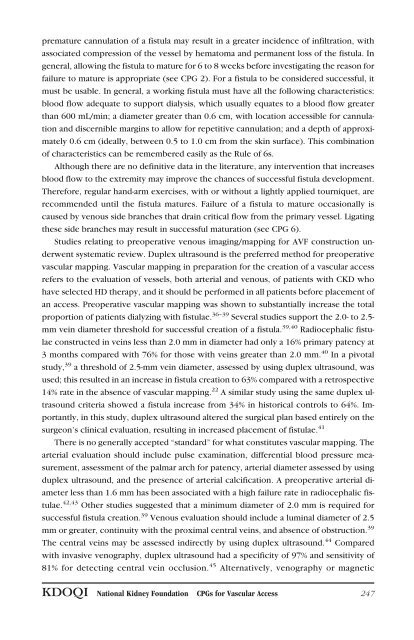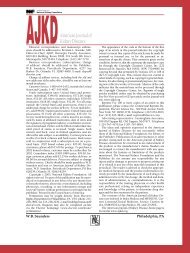2006 Updates Clinical Practice Guidelines and Recommendations
2006 Updates Clinical Practice Guidelines and Recommendations
2006 Updates Clinical Practice Guidelines and Recommendations
Create successful ePaper yourself
Turn your PDF publications into a flip-book with our unique Google optimized e-Paper software.
premature cannulation of a fistula may result in a greater incidence of infiltration, with<br />
associated compression of the vessel by hematoma <strong>and</strong> permanent loss of the fistula. In<br />
general, allowing the fistula to mature for 6 to 8 weeks before investigating the reason for<br />
failure to mature is appropriate (see CPG 2). For a fistula to be considered successful, it<br />
must be usable. In general, a working fistula must have all the following characteristics:<br />
blood flow adequate to support dialysis, which usually equates to a blood flow greater<br />
than 600 mL/min; a diameter greater than 0.6 cm, with location accessible for cannulation<br />
<strong>and</strong> discernible margins to allow for repetitive cannulation; <strong>and</strong> a depth of approximately<br />
0.6 cm (ideally, between 0.5 to 1.0 cm from the skin surface). This combination<br />
of characteristics can be remembered easily as the Rule of 6s.<br />
Although there are no definitive data in the literature, any intervention that increases<br />
blood flow to the extremity may improve the chances of successful fistula development.<br />
Therefore, regular h<strong>and</strong>-arm exercises, with or without a lightly applied tourniquet, are<br />
recommended until the fistula matures. Failure of a fistula to mature occasionally is<br />
caused by venous side branches that drain critical flow from the primary vessel. Ligating<br />
these side branches may result in successful maturation (see CPG 6).<br />
Studies relating to preoperative venous imaging/mapping for AVF construction underwent<br />
systematic review. Duplex ultrasound is the preferred method for preoperative<br />
vascular mapping. Vascular mapping in preparation for the creation of a vascular access<br />
refers to the evaluation of vessels, both arterial <strong>and</strong> venous, of patients with CKD who<br />
have selected HD therapy, <strong>and</strong> it should be performed in all patients before placement of<br />
an access. Preoperative vascular mapping was shown to substantially increase the total<br />
proportion of patients dialyzing with fistulae. 36–39 Several studies support the 2.0- to 2.5mm<br />
vein diameter threshold for successful creation of a fistula. 39,40 Radiocephalic fistulae<br />
constructed in veins less than 2.0 mm in diameter had only a 16% primary patency at<br />
3 months compared with 76% for those with veins greater than 2.0 mm. 40 In a pivotal<br />
study, 39 a threshold of 2.5-mm vein diameter, assessed by using duplex ultrasound, was<br />
used; this resulted in an increase in fistula creation to 63% compared with a retrospective<br />
14% rate in the absence of vascular mapping. 22 A similar study using the same duplex ultrasound<br />
criteria showed a fistula increase from 34% in historical controls to 64%. Importantly,<br />
in this study, duplex ultrasound altered the surgical plan based entirely on the<br />
surgeon’s clinical evaluation, resulting in increased placement of fistulae. 41<br />
There is no generally accepted “st<strong>and</strong>ard” for what constitutes vascular mapping. The<br />
arterial evaluation should include pulse examination, differential blood pressure measurement,<br />
assessment of the palmar arch for patency, arterial diameter assessed by using<br />
duplex ultrasound, <strong>and</strong> the presence of arterial calcification. A preoperative arterial diameter<br />
less than 1.6 mm has been associated with a high failure rate in radiocephalic fistulae.<br />
42,43 Other studies suggested that a minimum diameter of 2.0 mm is required for<br />
successful fistula creation. 39 Venous evaluation should include a luminal diameter of 2.5<br />
mm or greater, continuity with the proximal central veins, <strong>and</strong> absence of obstruction. 39<br />
The central veins may be assessed indirectly by using duplex ultrasound. 44 Compared<br />
with invasive venography, duplex ultrasound had a specificity of 97% <strong>and</strong> sensitivity of<br />
81% for detecting central vein occlusion. 45 Alternatively, venography or magnetic<br />
KDOQI National Kidney Foundation CPGs for Vascular Access 247
















